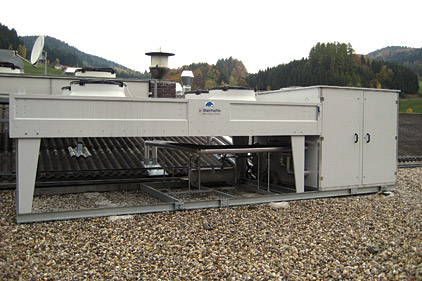
|
| The European focus on alternatives to f-gas refrigerants is reflected in this water chiller in Austria, which uses an azeotropic blend of ammonia and dimethyl ether. |
As Europe goes, so goes North America. That was a proven adage when it came to the phaseout of CFCs and HCFCs. Even these days, the North American HVACR market closely monitors developments in Europe for signs of what eventually may cross the Atlantic Ocean.
According to published reports, a number of policy initiatives are coming up for debate and possible passage during 2012 in the European Union (EU), the economic and political union of 27 countries. One topic high on the agenda is f-gas regulations.
As part of EU’s rotating presidency, Denmark takes over the presidency of the Council of the European Union for the first half of 2012. It is a country that heavily promotes green initiatives.
According to the website R744.com, “The Danish EU presidency has announced that green growth and promotion of low-carbon technologies are some of the top priorities to be pursued during its six-month term. Denmark will particularly strive to push for more stringent energy efficiency targets and increased renewable energy use at EU level.”
Currently, much of the focus in Europe when it comes to HFC refrigerants relates to containment and proper recovery methods, the same as in North America. At the same time, those who watch European dynamics see 2012 as being a time of debate and policy workshops regarding alternatives to HFC refrigerants.
National Plans
There is also talk about national heating and cooling plans.
According to R744.com, “Negotiations and political compromise over a proposal for an Energy Efficiency Directive in the EU is expected to peak in 2012, with the proposal entering consultation talks within the European Parliament in the first few months of the year. The directive proposes several supply- and demand-side energy-saving options, including a binding annual 3 percent renovation of public buildings and 1.5 percent savings for energy companies, as well as the setting up of ‘national heating and cooling plans’ by Member States for the promotion of combined heat and power generation and the use of heating and cooling from waste heat and renewable energy sources.”
Ecodesign
In Europe, minimum efficiency requirements for products are being called Ecodesign measures. The next wave of such regulations is expected to embrace heat pump boilers and water heaters, refrigerating and freezing equipment, and domestic tumble driers. There is also an Ecodesign Working Plan for 2012-2014, which will define additional types of products.
Fuel Taxes
Europe is also discussing an overhaul in the rules on taxation “of energy products that set minimum energy tax levels for heating and transport fuels in the EU,” said R744.com. “The proposed recast of the Energy Tax Directive introduces a CO2 tax component in addition to a tax on the energy content of fuels.
“According to the draft recast, EU Member States would have to levy a minimum rate of €20 per ton of CO2 on heating fuels other than electricity, the latter being regulated already under the EU emissions trading scheme (ETS).”
Also look for European nations to make decisions about ways to increase funding for research on environmental issues under the moniker “Horizon 2020.”
Publication date: 03/05/2012



Report Abusive Comment